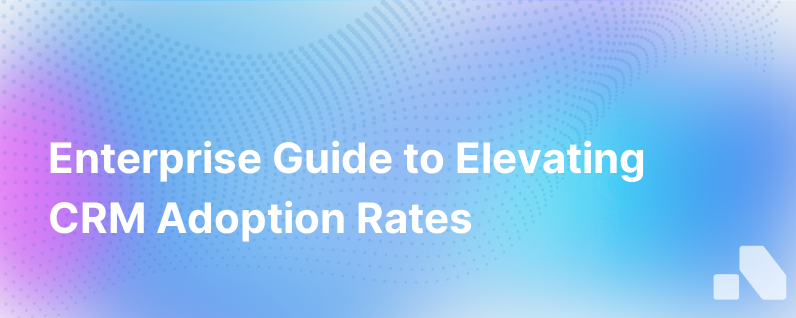
When it comes to managing customer relationships, the power of a Customer Relationship Management (CRM) system is undisputed. Its ability to gather and analyze customer data, streamline communications, and automate many aspects of the sales process makes it an invaluable tool. However, the best CRM system in the world is only as good as the people using it. In enterprises, CRM adoption can be a significant challenge. Organizations face numerous hurdles in encouraging system-wide adoption. But fear not; with the right strategy in place, you can increase CRM adoption throughout your enterprise.
1. Leadership Endorsement
Let's start at the top. When the leadership team fervently backs the usage of a CRM, it sends a clear message to the rest of the organization that the adoption is a priority. Leaders should not only promote the use of the CRM but actively engage with it themselves. Having executives use the system in their daily activities can dramatically influence the wider team.
2. Choose the Right System
CRM adoption often fails because the selected system doesn't align with the organization's processes and goals. It is imperative to choose a CRM that is intuitive, accessible, and able to integrate seamlessly with other tools your team uses. There should be a thorough vetting process, involving end users in the selection of the CRM to ensure it meets their needs.
3. Customization and Personalization
No two enterprises are exactly alike, and your CRM should reflect your unique business processes and workflows. Customizing your CRM to fit your organization's needs can help employees see its value and feel more comfortable using it. In addition, allowing individual users to personalize their dashboards and views can create a user-friendly experience that promotes regular use.
4. Comprehensive Training
One of the biggest barriers to CRM adoption is a lack of training. Ensure your team understands not only how to use the CRM but why it's beneficial to their own work processes. Training should be varied to cater to different learning styles—include in-person sessions, video tutorials, and written guides.
5. Provide Continuous Support
After the initial training, support should continue to be readily available. Staff may need refreshers or have questions that arise as they use the CRM more extensively. Creating a support structure that could include help-desk services, dedicated internal CRM champions, or community forums can be particularly effective.
6. Integration with Other Systems
A CRM system that works well with other tools and systems can reduce the resistance to its adoption. By integrating CRMs with email systems, calendars, marketing automation tools, and more, employees can work within a familiar ecosystem, reducing the friction of adopting another separate system.
7. Simplify Data Entry
Data entry is often a significant part of using a CRM and arguably the most tedious. To increase adoption, this process should be as simple as possible. Optimize data entry with automation and data import tools, and ensure that the CRM can easily capture information from various touchpoints.
8. Ensure Data Quality and Relevance
A CRM is only as good as the data within it. Encouraging teams to maintain data cleanliness ensures the CRM remains a valuable and reliable resource. Establish regular check-ins or audits to ensure data quality is maintained and the system doesn't become cluttered with outdated or irrelevant information.
9. Show the Value
Demonstrate to your team the tangible benefits of using the CRM. Share success stories, quantifiable results from CRM reports, and praise individuals who have used it to achieve success. Highlighting real examples of how the CRM can make their job easier and help them meet their sales targets can motivate employees to adopt the system in their daily routines.
10. Incentivize Use
Sometimes, a gentle nudge is all it takes to encourage behavior change. Consider introducing incentives or gamification into the CRM experience. Competitions, recognitions, or even tangible rewards for diligent CRM use can foster an environment where adoption is not only supported but encouraged.
11. Regular Feedback Loops
Adoption is a two-way street. Regularly solicit feedback from users and be open to making changes based on their experiences. Not only does this improve the system for everyone, but it also makes employees feel valued and involved in the CRM's development, increasing their commitment to using it.
12. Measure Adoption and Use Analytics
Monitoring how your CRM system is being utilized provides a clear picture of adoption rates. Use CRM analytics to track who's logging in, updating records, or utilizing various features. Regular reviews of this data can help identify areas where adoption may be lagging and necessitate additional support or training.
13. Keep Evolving
Technologies and business processes are continually changing and so should your CRM. Make sure that your CRM adapts to new business conditions and evolves to meet the changing needs of the users. Keeping the CRM modern and relevant encourages ongoing adoption.
14. Foster a Customer-Centric Culture
Ultimately, CRM adoption is about facilitating better customer relationships. Create a culture that emphasizes the importance of customer data and interactions. When teams understand that a CRM helps them serve their customers more effectively, they're more likely to see its value.
Conclusion
Increasing CRM adoption enterprise-wide is critical for leveraging the full potential of your CRM investment. By securing executive endorsement, selecting the right system, offering ongoing training and support, and demonstrating the value, you can foster an environment that promotes CRM adoption. Remember, adoption is a process, not an event. It requires patience, understanding, and continuous effort. By following these steps, you'll pave the way for a CRM-enabled workforce that's more productive, data-driven, and customer-focused.